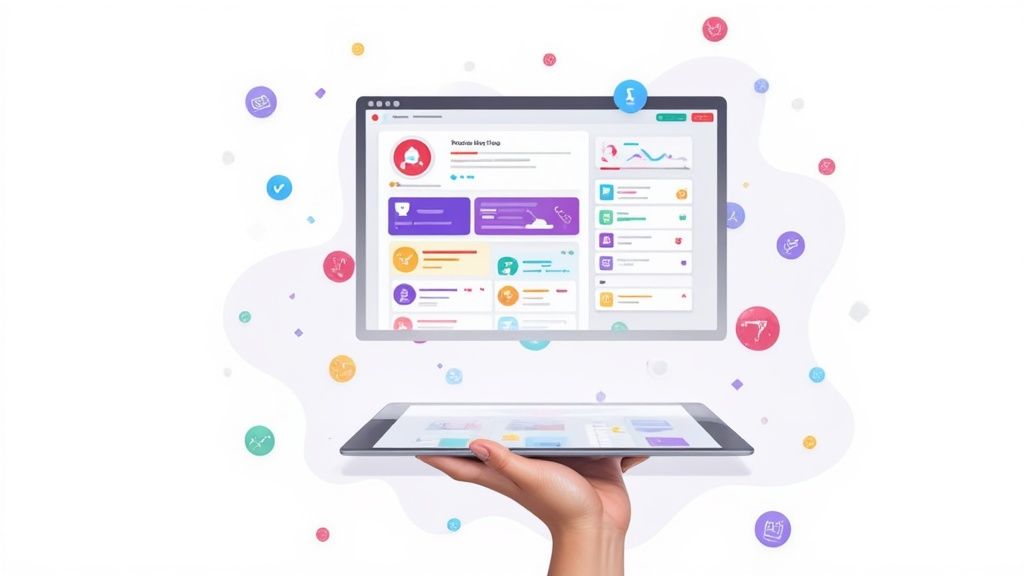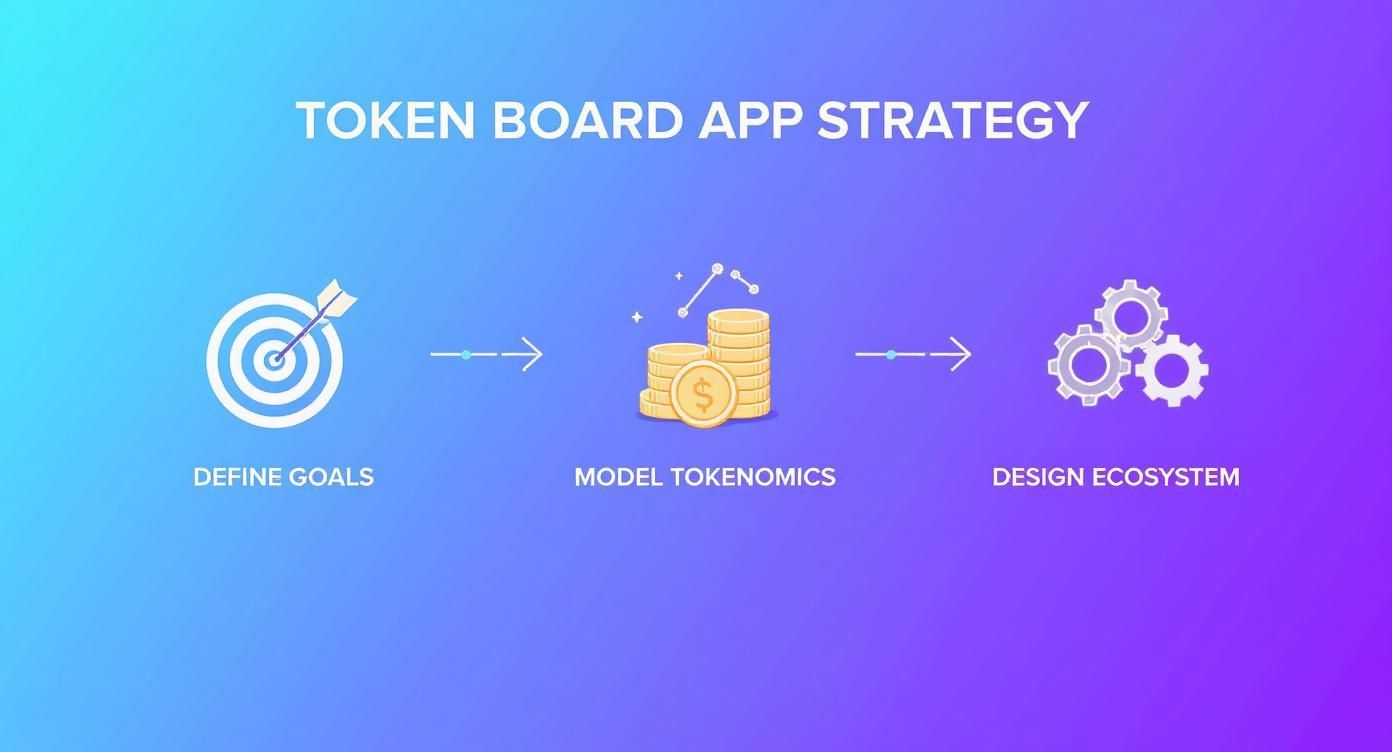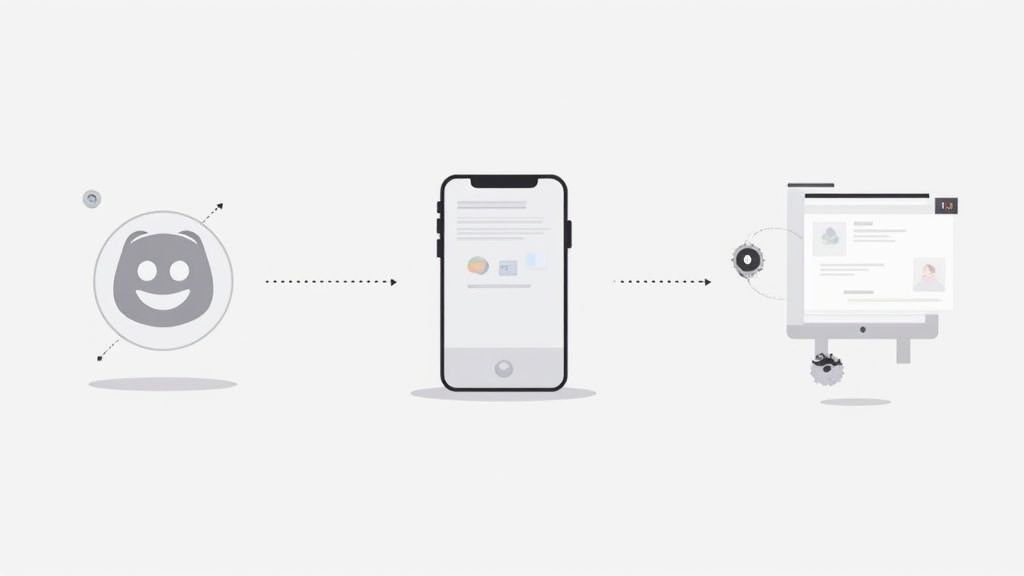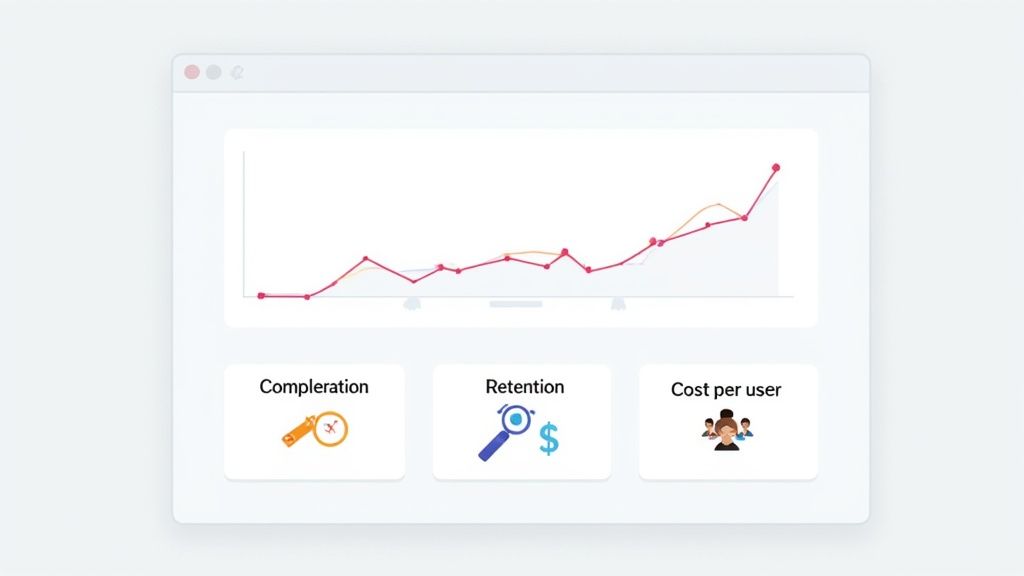Create a token board app: Engage Users with Quests

A token board app is your secret weapon for turning passive community members into active contributors. Think of it as a loyalty program for Web3, where you reward people with points or tokens for completing tasks that actually help your project grow. It gamifies engagement, but the real magic isn't in the tech—it's in the strategy you build before you even think about the app itself.
Laying the Foundation for a Winning Token Board
Look, you can have the slickest app in the world, but if it doesn't have a purpose, it's just noise. The most successful token boards I've seen are built on a rock-solid strategic foundation. This initial planning phase is what separates the campaigns that build real, lasting value from the ones that create a quick spike in activity and then fade into obscurity. It all comes down to knowing why you're building this and what you need it to do.
From Vague Goals to Concrete Actions
The first step? Get specific. "Boosting engagement" is a terrible goal because it means nothing. What does engagement actually look like for your project?
You need to translate that fuzzy idea into measurable objectives. For example:
- Boost Protocol Usage: Maybe you want to see a 20% increase in daily swaps on your DEX or get 500 more users to stake their assets. The quests you design should directly push people toward those actions.
- Drive User Onboarding: Is your main goal to get new people comfortable with your platform? Then your token board should function as an interactive tutorial, guiding them through the key features one quest at a time.
- Incentivize Content Creation: If you're starving for good user-generated content, then your quests should reward people for creating killer tutorials, hilarious memes, or insightful Twitter threads about your project.
- Grow a Specific Community Segment: Trying to attract more developers? Simple. Create quests that reward them for contributing to your GitHub, participating in technical AMAs, or building on your testnet.
This is the exact flow I follow when mapping out a new program. It all starts with the 'why'.

As you can see, those initial goals become the blueprint for everything else you build. Get this part wrong, and the rest doesn't matter.
Building a Sustainable Token Economy
With clear goals in hand, you can now start thinking about the tokenomics. This is where a lot of projects stumble. You're not just throwing tokens at people; you're building a mini-economy. The rewards need to be juicy enough to get people excited, but not so generous that you create runaway inflation and attract a swarm of airdrop farmers who will dump on you the first chance they get.
I’ve seen this happen time and time again: projects over-reward simple, low-value tasks like "follow us on Twitter." This cheapens your token and, worse, it fails to build a community that's genuinely invested in your success. The biggest rewards should always be tied to the actions that create the most value for your ecosystem.
You need to be deliberate about your total reward pool, how you'll distribute it over time, and the specific actions that unlock those rewards. A thoughtful system brings in the right crowd and keeps them around for the long haul. If you want to get into the nitty-gritty of designing these systems, we've got a whole guide on racking up points that you'll find useful.
Designing Quests That Actually Get People Hooked

Let’s be honest: a token board is only as good as the quests you fill it with. If you just throw a bunch of generic tasks at your community, you’ll get generic, low-effort engagement. That's not how you build a real community.
The secret sauce is mixing things up. You need a blend of quests that are genuinely fun for people to do but also secretly nudge them toward actions that help your project grow. This means looking past the tired old "like and retweet" model. While those have a place, they can't be the main course. Real value comes from a smart mix of creative off-chain challenges and critical on-chain activities.
Crafting Compelling Off-Chain Quests
Off-chain quests are your creative playground. This is where you build culture and get your community to generate amazing content for you. The best part? They don't require gas fees, so anyone can jump in.
Forget just asking for follows. Think bigger.
- Spark Some Creativity: Run a meme contest or challenge people to create the most insightful Twitter thread about your protocol. You could even offer a bounty for the best short video tutorial.
- Test Their Knowledge: Create a quick quiz based on your whitepaper or a new feature. This is a sneaky way to make sure people are actually understanding what you're building.
- Level-Up Your AMAs: Instead of a free-for-all, reward users for submitting the most thoughtful questions for your next AMA. You'll get much deeper conversations out of it.
You can borrow a lot of great ideas from the gaming world here. Many of the retention strategies from guides on how to make a game app can be adapted to keep your community coming back for more.
Driving On-Chain Actions That Actually Matter
On-chain quests are where your token board transforms into a powerful growth engine. These are the tasks that should directly link back to your main goals, getting people to actually use your protocol.
The most effective on-chain quests don't feel like a to-do list. They feel like a guided tour of your ecosystem, turning passive followers into active, hands-on users.
If you’re a DeFi protocol, for example, your quests could walk users through:
- Making their first swap: A simple entry point that gets them comfortable with your core feature.
- Minting a special NFT: A great way to drive participation in a new collection or loyalty program.
- Adding liquidity: A more advanced action that rewards users for directly contributing to the protocol's stability.
Getting this right is a huge deal, especially as the market for tokenized assets explodes. This space has rocketed to over $21 billion from just $85 million in 2020. Projects that can guide users toward these high-value actions are the ones that will win. If you want to dive deeper, check out this excellent introduction to the token economy.
Let AI Handle the Busywork
Imagine trying to manually verify thousands of tweets, Discord reactions, and meme submissions. It's a logistical nightmare. This is where automation, especially with AI, becomes your best friend.
AI can instantly scan a tweet for a specific hashtag, confirm a user reacted to a Discord announcement, or even do a first pass on user-generated content to weed out the spam.
This isn't just about saving your team a ton of time. It gives users instant gratification, which is key to keeping them engaged. Building that daily habit is what it's all about, something we talk about more in our post on the power of a daily check-in. By automating the boring stuff, you’re free to focus on what really matters: dreaming up the next awesome quest.
Picking the Right Frontend and Tech Stack
So, you've designed some killer quests. Now for the million-dollar question: where will your community actually do them? This decision is bigger than it seems because it shapes the entire user experience of your token board. The key is to meet people where they already are and make it dead simple to get involved.

This isn't just about picking a random platform; it's about crafting the perfect environment for your community's journey. Let's dig into the most common routes people take.
Meeting Users Where They Live: Discord & Telegram
For pretty much any Web3 project, the community lives and breathes in Discord or Telegram. So, why not bring the quests directly to them? By using a bot, you can dish out tasks, check submissions, and post leaderboards right inside the chats they have open all day.
The massive win here is zero friction. No new website to sign up for, no app to download. It just works. This native approach feels incredibly seamless and keeps the focus squarely on community interaction.
Using Dedicated Questing Platforms
There's a reason platforms like Zealy, Galxe, and Layer3 have blown up. They give you a polished, feature-packed experience straight out of the box. We’re talking gamified leaderboards, tons of quest templates, and automated verification tools without needing to touch a line of code.
Think of it as the Shopify for Web3 community campaigns. It's the perfect play for teams who need to launch fast and want to tap into a platform where users are already actively looking for new projects to engage with. You get a professional-looking home for your token board app, fast.
My two cents: The trade-off with these platforms is branding. You get convenience, but your campaign will always be living in someone else's house. For projects that need a completely unique, branded journey, this might feel a bit restrictive.
And that brings us to the high-effort, high-reward option.
The White-Label Custom Experience
If you need total control over the look, feel, and user flow, then a white-label or fully custom build is your answer. This path lets you build a questing portal on your own domain that’s a perfect extension of your brand and product.
This is the go-to for more established projects that want to weave the token board deep into their existing ecosystem. Be warned, though—this route demands serious technical resources and a much bigger budget. You're not just running a one-off campaign; you're building and maintaining a full-fledged product. It's a power move, but only if you have the team to back it up.
Frontend Platform Comparison for Your Token Board App
Choosing a frontend can feel overwhelming, so I've put together this quick comparison table to help you weigh the options based on what truly matters for your project.
| Platform | Best For | Key Advantage | Consideration |
|---|---|---|---|
| Discord/Telegram Bots | Projects with highly engaged, chat-centric communities. | Zero friction. Users never have to leave the app they use daily. | Limited to the UI constraints of the chat platform; can feel less "premium." |
| Dedicated Platforms (Zealy, Galxe) | Teams needing a fast launch with proven gamification features. | Speed and network effects. Launch in hours and tap into an existing user base. | Less brand control; you're operating within another company's ecosystem. |
| White-Label/Custom Build | Established projects wanting a fully branded, integrated experience. | Total customization. The experience is 100% yours, from URL to UI. | Requires significant development resources, budget, and ongoing maintenance. |
Ultimately, the best choice depends on your resources, timeline, and how central this quest board is to your overall community strategy. Don't over-engineer it if a simple bot will do, but don't sell your brand short if a custom experience is what your community deserves.
Time to Launch and Spread the Word
You've done the hard work—the quests are designed, the rewards are set, and your tech is ready to go. Now for the fun part: launching your quest program. This isn't just about flipping a switch; a great launch is a planned event that builds a ton of hype and gets people engaged from the very first minute. The last thing you want is a ghost town on day one.
The real work starts a couple of weeks before you even think about going live. This is when you start teasing what’s coming. Drop hints on Twitter, share sneak peeks in Discord, and get people curious about the rewards and challenges you have in store. This is also the perfect time to prep some simple how-to content, like a quick video or a simple blog post, so your community knows exactly what to do when the gates open.
Making a Splash on Launch Day
When the big day finally arrives, treat it like a party. Your job is to grab everyone's attention and give them a reason to jump in immediately. That initial surge of activity is what makes a platform feel alive and exciting.
Here are a few tactics that work wonders:
- Go Live with an AMA: Host a Twitter Space or a Discord stage event. Walk everyone through the new quest board, answer their questions live, and get them hyped about the vision.
- Drop a Day-One Exclusive: Create a special, high-value quest that’s only available for the first 24-48 hours. Nothing creates urgency like a little bit of FOMO.
- Team Up with Influencers: Find a few key voices in your space and give them early access. Have them share their genuine experience with their followers to build trust and expand your reach.
This kind of strategic push is more important than ever. With the number of crypto users hitting an estimated 420 million worldwide, a well-planned launch helps you cut through the noise. You can see more data on this user growth on Statista.com.
Rallying Your Core Community
Your existing community is your secret weapon, so put them to work. Blast an announcement out to your email list with a direct link to the quest board. Pin the news in your Discord and Telegram so nobody can miss it. Create a killer Twitter thread that walks through the first few quests and shows off the rewards.
Pro Tip: Don't just announce your quest program—celebrate it. Position it as a huge step forward for the community, a new way for them to contribute and earn their place. That kind of positive energy gets people way more excited than a standard feature update.
Remember, those first users are your social proof. When new people arrive and see others actively completing quests and earning rewards, it creates a powerful feedback loop. That initial momentum is what will carry your program long after the launch-day confetti has settled. For some extra creative fuel, check out our guide on building a treasure hunter's quest.
Using Analytics to Optimize and Grow
Alright, your token board is live. Quests are out in the wild, and your community is starting to get active. So, you can kick back and relax, right? Not so fast.
Getting your board launched is really just the starting line. The real magic—and the real work—is in what comes next. Long-term success isn't about setting it and forgetting it; it’s about listening to the data and constantly tweaking your approach.
Without solid analytics, you’re flying blind. You have to look past feel-good numbers like total sign-ups and zero in on the key performance indicators (KPIs) that tell you what’s actually working. A good dashboard is your new best friend.

This kind of data-first mindset is essential. The global tokenization market recently hit about USD 4.1 billion and is expected to rocket to USD 10.46 billion by 2029. To keep up, you need to be optimizing constantly, and that's impossible without data backing your decisions.
Identifying What Truly Matters
It’s easy to drown in a sea of numbers. To stay focused, I always recommend concentrating on a handful of core metrics that give you a clear signal on the health of your quest program.
Here are the KPIs I’d be watching like a hawk:
- Quest Completion Rate: This is your bread and butter. Which quests are people actually finishing? Which ones are they starting and then abandoning? A low completion rate could mean the task is too confusing, the reward is too low, or it's just plain boring.
- User Retention: This is a big one. Of the people who complete one quest, how many stick around to do another? This tells you if you're building a real engagement loop or just offering a one-time gimmick.
- Cost Per Active Participant: Simply divide your total rewards budget by the number of users who are consistently active. This keeps your ROI in check and makes sure you're not just burning cash.
- Time-to-Complete: How long does it actually take someone to finish a quest? If a task you figured would take five minutes is actually taking an hour, you've found a major friction point that needs fixing.
Turning Insights into Action
Once you start pulling in this data, the real fun begins. You can start making smart, informed decisions instead of just guessing what your community wants.
Don't be afraid to kill your darlings. If a quest you personally love has a terrible completion rate after a few weeks, it's not working. Ditch it and replace it with something your community actually wants to do.
Your analytics should directly inspire your next move. For example, if you see a huge drop-off on a multi-step on-chain quest, you know you either need to simplify the steps or provide a much clearer guide. On the flip side, if your simple "follow us on Twitter" quest gets massive engagement, it's a sign to create more low-effort, high-reward social tasks.
To really dial things in, it’s critical to measure marketing effectiveness and connect your promotional efforts to actual user behavior. This constant cycle of tracking, analyzing, and optimizing is what turns a token board from a fun little campaign into a sustainable engine for community growth.
Got Questions? We've Got Answers.
Even with a solid game plan, a few nagging questions always seem to pop up when you're piecing together a token board app. It's completely normal. Let's tackle some of the most common worries I hear from teams so you can push forward with confidence.
How Do I Stop Bots and Farmers?
This is the big one, and let's be real: there's no single magic bullet. Your best defense is always going to be a layered one.
First, start with some basic identity checks. This could be as simple as verifying a wallet's age or requiring users to link a social account like Twitter or Discord. It’s not foolproof, but it does create a hurdle that stops the laziest farmers in their tracks.
Next up, get creative with your quests. Design tasks that demand actual human thought and effort. A bot is going to have a tough time creating a genuinely funny meme or writing a thoughtful thread about your project. This is also where AI verification tools shine—they can automatically flag low-effort, spammy submissions, which saves you a ridiculous amount of time on manual reviews.
Finally, you have to be vigilant. Keep an eye on user activity. If you suddenly see a bunch of accounts completing quests from the same IP address or all showing the exact same behavioral patterns, you’ve probably found a bot farm. Don't hesitate to bring down the ban hammer. Keeping the playing field fair is non-negotiable if you want to keep your real community members happy and engaged.
What's the Biggest Mistake Projects Make?
Without a doubt, it's launching with a completely broken or unsustainable tokenomics model. It happens all the time.
So many projects fall into the trap of offering huge rewards for super simple, low-value tasks right out of the gate. Sure, it creates a temporary sugar rush of activity, but it only attracts the "farm and dump" crowd. These users have zero real interest in your project. They'll just bleed your rewards pool dry and tank your token's price on their way out the door.
The fundamental error is disconnecting rewards from actual value creation. Your quest program needs to be a balanced ecosystem, not just an open wallet.
The fix? Be strategic. Kick things off with a reasonable, clearly defined rewards budget. More importantly, link your biggest rewards to actions that genuinely move the needle for your protocol—things like providing liquidity or referring a new, active user. Don't forget to mix in non-monetary rewards, too! Exclusive NFTs, special Discord roles, or reputation points can build a type of loyalty that money just can't buy.
Should I Build a Custom App or Just Use a Platform?
This question comes up constantly, and for most projects, the answer is refreshingly straightforward.
For almost everyone starting out, using an established platform like Zealy, Galxe, or Layer3 is the smartest play you can make. Seriously. These platforms handle all the heavy lifting for you—from quest creation and automated verification to leaderboards and distributing rewards. You can get a professional-looking token board app live in a matter of hours, not months.
This approach lets you test your ideas and prove that your community is actually into it without sinking a massive amount of cash into development right away.
You should only even consider a custom build if you have incredibly specific needs that existing platforms just can't handle, like a unique, deep integration with your own protocol's backend. It's always better to validate your quest strategy on a third-party platform first. Once you have a proven model that works, then you can think about the significant time and cost of building your own solution from scratch.
Ready to launch your own quest program without the headache? With Domino, you can design and automate engaging on-chain and off-chain quests in minutes, no code required. Join the top Web3 teams who have already powered over 25 million quest completions. Start building your community with Domino today!
Level Up Your dApps
Start using Domino in minutes. Use automations created by the others or build your own.
